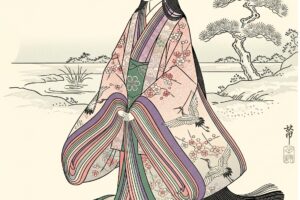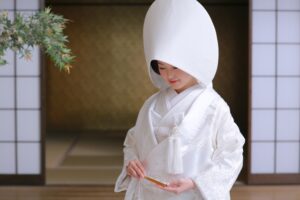舞台の上には、松が描かれた簡素な背景だけ。ゆっくりと現れる面をつけた演者は、決して感情を露わにしません。しかし、その静寂と抑制された動きの中に、私たちは時として激しい情念や深い悲しみ、そしてこの世ならざるものの存在を感じ取ります。これこそが、650年以上の長きにわたり、人々の心を捉えてきた日本の伝統芸能「能」の世界です。単なる古典芸能と侮るなかれ。そこには、現代を生きる私たちの心にも深く響く、普遍的な物語と洗練の極致ともいえる美学が息づいています。
- 引き算の美学: なぜ能の動きはあんなにも静かなのか?何もない空間にすべてを見る、その表現の秘密に迫ります。
- 幽玄という名の宇宙: 死者や亡霊が主人公となる物語。時間と空間を超えて描かれる、人の心の深淵とは。
- 伝統とは革新の連続: 古典でありながら、常に新しい「花」を求めた世阿弥の精神。現代に生きる能の姿を追います。
幽玄への扉、能楽の始まり
能は、その源流を辿ると、奈良時代に中国から伝わった「散楽」や、平安時代の「猿楽」「田楽」といった民衆芸能に行き着きます。これらが洗練され、ひとつの舞台芸術として大成されたのが、室町時代。観阿弥(かんあみ)、そしてその息子である世阿弥(ぜあみ)という二人の天才の登場によって、能は武家社会の式楽(公式な芸能)としての地位を確立し、その芸術性を飛躍的に高めました。特に世阿弥が著した理論書『風姿花伝』は、単なる演劇論に留まらず、現代のビジネスやアートの世界にも通じる普遍的な哲学として、今なお読み継がれています。彼らが築き上げたのは、単なる娯楽ではなく、精神性を深く追求する舞台芸術の礎だったのです。
面と装束が織りなす心の万華鏡
能の舞台を観て、まず目を引かれるのが、主人公である「シテ」がつける能面でしょう。小面(こおもて)に代表される女面、あるいは勇壮な武将や恐ろしい鬼の面。これらの面は一見すると無表情ですが、決してそうではありません。演者が顔を少し俯ける「クモル」という仕草で悲しみを、逆に少し上げる「テラス」という仕草で喜びを表現するなど、面の角度と光の当たり具合、そして演者の身体の動きが一体となることで、一つの面が無限の表情を生み出すのです。
そして、その身体を包むのが、豪華絢爛な能装束です。美しい刺繍や織りが施された装束は、単に役柄の身分や性別を示すだけでなく、その人物の内面、例えば燃え上がる嫉妬の炎や、秘めた恋心といった抽象的な感情までも象身しています。抑制された動きの中で、唯一彩りと雄弁さを持つ装束は、観客の想像力をかき立て、物語の世界へと深く誘う重要な役割を担っているのです。
時間と空間を超える夢幻能の世界
能の物語は、大きく「現在能」と「夢幻能(むげんのう)」に分けられます。特に能の真髄を示すとされるのが、夢幻能です。この形式では、諸国を旅する僧などの「ワキ」が、ある土地で一人の人物(前シテ)に出会います。その人物は、その土地にまつわる物語を語り、実は自分こそがその物語の主人公の亡霊であると明かして姿を消します。夜になり、ワキの夢の中に、生前の姿(後シテ)で再び現れた亡霊は、自らの過去の栄光や苦悩、執心を舞や謡で再現して見せるのです。
なぜ、このような幻想的な構造が生まれたのでしょうか。それは、現実世界のしがらみから解放された夢や霊の世界でこそ、人間の最も純粋な感情や魂の叫びを描き出すことができると考えられたからかもしれません。生者と死者、現実と夢が交錯する中で、私たちは普段意識することのない、人の世の儚さや普遍的な情念に触れることになります。これこそが、能が持つ「幽玄」という独特の美意識の核心なのです。
古典にして、常に最先端
「秘すれば花なり、秘せずは花なるべからず」。これは、世阿弥が『風姿花- 伝』に残した有名な言葉です。観客をあっと言わせるような新しい魅力、それこそが「花」であり、そのためには絶え間ない稽古と工夫が必要だと説いています。つまり、能は生まれた時から、伝統の継承と同時に、常に革新を求める精神を内包していたのです。
その精神は、現代にも脈々と受け継がれています。古典作品が繰り返し上演される一方で、新しい題材や演出を取り入れた「新作能」も意欲的に創作されています。また、海外のアーティストとのコラボレーションや、異ジャンルの演劇祭への参加など、その表現の場は国境やジャンルを超えて広がり続けています。650年の時を経てなお、能が私たちに新しい感動を与えてくれるのは、この「花」を求め続ける精神が、演者から演者へと、確かに受け継がれているからに他なりません。
解説ポイント①:引き算の美学
能の舞台は、極限まで無駄を削ぎ落とした「引き算の美学」で構成されています。背景には松の絵、舞台上には作り物が置かれることもありますが、基本的には何もない空間です。演者の動きも、走ったり跳んだりすることはなく、「すり足」という静かな移動が基本です。しかし、この「何もない」ことこそが、能の表現の豊かさの源泉となっています。例えば、演者が数歩すり足で進むだけで、そこは都から遠く離れた鄙(ひな)の地となり、扇をかざせば、それは満月にも、酒盃にもなります。すべてを具体的に説明しないからこそ、観客は自らの想像力を最大限に働かせ、役者の謡や囃子の響きを頼りに、心の中に無限の風景や情景を描き出すのです。情報過多の現代において、この想像力に委ねる芸術は、非常に贅沢な体験と言えるでしょう。
解説ポイント②:幽玄という名の宇宙
能の神髄と評される「幽玄」とは、一体何でしょうか。それは、舞台の表面に現れる美しさの奥に広がる、深く静かで、計り知れない趣や情趣を指す言葉です。そして、その幽玄の世界観を最も体現しているのが、死者や亡霊が主役となる「夢幻能」の形式です。なぜ現実に生きる人間ではなく、この世ならざる者たちが物語の中心に据えられるのでしょうか。それは、彼らがもはや現世の利害や時間の制約に縛られていない存在だからです。過去に犯した過ちへの悔恨、遂げられなかった恋への執心、失われた栄光への渇望。そうした、生身の人間が心の奥底に封印している純粋で根源的な感情を、亡霊というフィルターを通して、より鮮烈に、そして普遍的なものとして描き出すことができるのです。観客は、亡霊の物語に自らの人生を重ね、時空を超えた魂の共振を体験します。
解説ポイント③:伝統とは革新の連続
「伝統芸能」と聞くと、古くから伝わる型を忠実に守り続ける、変化のない世界を想像するかもしれません。しかし、能を大成させた世阿弥は、むしろ「変化」と「新しさ」を極めて重視しました。「時々の感当りをしらずして、易き方の芸ばかりをすれば、初心の能は、はや初心にて失すなり」(その時々の観客の心に響くものを知らずに、簡単な芸ばかりしていては、若い頃に得た新鮮な魅力はすぐに失われてしまう)。これは『風姿花伝』の一節ですが、彼の思想の核心がここにあります。一つの型に安住するのではなく、常に観客を魅了する新しい「花」を探し求め、変化し続けることこそが、真の伝統を守ることにつながるというのです。この精神に基づき、現代でも三島由紀夫作の近代能楽集が上演されたり、全く新しいテーマで「新作能」が作られたりしています。能が650年以上も命脈を保ち、今なお人々を惹きつけるのは、それが単なる「保存された古典」ではなく、常に時代と対話し、革新を続ける「生きた芸術」だからなのです。
参考文献
- 国立能楽堂. (n.d.). 能楽のたのしみ. https://www.ntj.jac.go.jp/nougaku/enjoy/
- https://www.google.com/search?q=the%E8%83%BD.com. (n.d.). 能楽(能と狂言)とは. https://www.the-noh.com/jp/about/
- 文化庁. (n.d.). 文化遺産オンライン: 能楽. https://bunka.nii.ac.jp/heritages/detail/197116
- 刀剣ワールド. (n.d.). 伝統芸能「能」の解説. https://www.touken-world.jp/history/art-culture/noh/
- 観世会. (n.d.). 能とは. https://www.kanze.net/about-noh
【English Article】
【Noh】Welcome to the World of Noh: A 650-Year-Old Stage Art That Moves the Modern Heart
On the stage, there is only a simple backdrop of a painted pine tree. An actor, wearing a mask, appears slowly, never revealing raw emotion. Yet, in that silence and restrained movement, we can sense fierce passions, deep sorrow, and the presence of the supernatural. This is the world of “Noh,” a Japanese traditional art form that has captivated audiences for over 650 years. Do not dismiss it as mere classical theater; it breathes with universal stories and a sublime aesthetic that resonates deeply with our modern lives.
- The Aesthetics of Subtraction: Why are Noh movements so quiet? We delve into the secret of its expression, where an empty space contains everything.
- The Universe of “Yugen”: Stories where the dead and ghosts are the protagonists. What is the abyss of the human heart depicted beyond time and space?
- Tradition is a Series of Innovations: Zeami’s spirit, which, while classical, always sought a new “flower.” We follow the form of Noh that lives on today.
The Door to Yugen: The Origins of Noh
Noh’s origins can be traced back to “Sangaku,” a form of public entertainment introduced from China during the Nara period (710-794), and “Sarugaku” and “Dengaku” from the Heian period (794-1185). It was during the Muromachi period (1336-1573) that these forms were refined and elevated into a high art. The emergence of two geniuses, Kan’ami and his son Zeami, propelled Noh to the status of shikigaku (official ceremonial art) for the warrior class, dramatically enhancing its artistic quality. Zeami’s theoretical treatise, Fūshikaden (The Flowering Spirit), is not just a text on theater but a universal philosophy applicable to modern business and art, and it continues to be read today. What they built was not mere entertainment, but the foundation of a stage art that deeply pursues spirituality.
The Kaleidoscope of the Heart Woven by Masks and Costumes
When watching a Noh performance, the first thing that catches the eye is the Noh mask (nōmen) worn by the protagonist, the shite. These can range from the female masks represented by the Ko-omote (young woman’s mask) to the masks of valiant warriors or terrifying demons. At first glance, these masks appear expressionless, but that is far from the truth. A single mask can produce infinite expressions through the actor’s movements. A slight downward tilt, known as kumoru, expresses sadness, while a slight upward tilt, terasu, conveys joy. The angle of the mask, the play of light, and the actor’s physical movements all unite to breathe life into the inanimate.
Enveloping the actor’s body are the gorgeous and ornate Noh costumes (nō-shōzoku). These garments, adorned with beautiful embroidery and weaving, do not merely indicate the character’s status or gender. They also symbolize the character’s inner world—abstract emotions like the burning flames of jealousy or a secret love. In the midst of restrained movement, the colorful and eloquent costumes are the only elements that stimulate the audience’s imagination, playing a crucial role in drawing them deeper into the story’s world.
The World of Mugen Noh: Transcending Time and Space
Noh plays are broadly divided into two categories: Genzai Noh (present-time Noh) and Mugen Noh (phantasmal Noh). It is Mugen Noh that is often said to represent the true essence of Noh. In this format, a traveling monk or other character, the waki, encounters a person (the mae-shite, or first-act protagonist) at a certain location. This person recounts a tale associated with the land and then reveals themselves to be the ghost of that story’s protagonist before disappearing. Later that night, the ghost reappears in the waki‘s dream in its form from its living days (the nochi-shite, or second-act protagonist) and, through dance and chant, relives its past glory, suffering, or obsession.
Why did such a fantastical structure emerge? Perhaps it was believed that the purest human emotions and cries of the soul could only be depicted in the world of dreams and spirits, freed from the constraints of reality. As the living and the dead, reality and dream, intersect, we touch upon the transience of human existence and universal passions that we are not normally conscious of. This is the core of the unique aesthetic of Noh known as yugen (profound and subtle grace).
Classical, Yet Always Cutting-Edge
“To conceal it is the flower; not to conceal it is not the flower.” This is a famous quote left by Zeami in his Fūshikaden. The “flower” (hana) is the fresh charm that astonishes the audience, and to achieve it, he preached the necessity of constant practice and ingenuity. In other words, from its very inception, Noh has embodied a spirit of innovation alongside the inheritance of tradition.
This spirit continues to thrive today. While classical works are performed repeatedly, “new Noh” (shinsaku nō) incorporating new themes and staging are also being ambitiously created. Furthermore, the stage for Noh expression continues to expand beyond borders and genres through collaborations with international artists and participation in various theater festivals. The reason Noh can still offer us new excitement after more than 650 years is that this spirit of seeking the “flower” has been faithfully passed down from one performer to the next.
Analysis Point ①: The Aesthetics of Subtraction
The Noh stage is constructed upon an “aesthetics of subtraction,” where all excess is stripped away. The backdrop features only a painted pine tree, and while some props may be placed on stage, it is fundamentally an empty space. The actors’ movements are also minimal; there is no running or jumping, and the basic form of movement is a quiet, sliding walk called suriashi. However, this very “emptiness” is the source of Noh’s expressive richness. For example, a few steps of suriashi can transform the stage from the capital to a remote countryside, and raising a fan can represent the full moon or a sake cup. By not explaining everything concretely, the audience is prompted to use their imagination to the fullest, creating infinite landscapes and scenes in their minds guided only by the actor’s chant and the music of the hayashi orchestra. In our age of information overload, this art form that entrusts so much to the imagination is a truly luxurious experience.
Analysis Point ②: The Universe of “Yugen”
What exactly is yugen, the term often used to describe the essence of Noh? It refers to a deep, quiet, and immeasurable charm and elegance that lies beyond the surface beauty of the stage. This worldview is most embodied in the Mugen Noh format, where the main characters are the dead or ghosts. Why are these supernatural beings, rather than living people, placed at the center of the story? It is because they are no longer bound by worldly interests or the constraints of time. Regret for past mistakes, obsession with an unfulfilled love, a craving for lost glory—these pure, fundamental emotions, which living people seal away deep in their hearts, can be depicted more vividly and universally through the filter of a ghost. The audience overlaps their own lives with the ghost’s story, experiencing a spiritual resonance that transcends time and space.
Analysis Point ③: Tradition is a Series of Innovations
When we hear “traditional arts,” we might imagine a static world that faithfully preserves ancient forms without change. However, Zeami, the master who perfected Noh, placed great importance on “change” and “novelty.” “If a performer, ignorant of what will appeal to the audience of the moment, performs only in an easy manner, the flower of his youth will wither as soon as it has bloomed.” This passage from Fūshikaden reveals the core of his philosophy. True tradition is not about clinging to a single form but about constantly seeking a new “flower” that will captivate the audience and continuing to evolve. Based on this spirit, modern Noh plays written by authors like Yukio Mishima are still performed, and “new Noh” pieces with entirely new themes are created. The fact that Noh has survived for over 650 years and continues to attract people today is because it is not merely a “preserved classic” but a “living art” that constantly engages in dialogue with the times and continues to innovate.
References
- National Noh Theatre. (n.d.). Nohgaku no tanoshimi (The Joy of Nohgaku). https://www.ntj.jac.go.jp/nougaku/enjoy/
- the-noh.com. (n.d.). Nōgaku (Nō to Kyōgen) to wa (What are Noh and Kyogen?). https://www.the-noh.com/jp/about/
- Agency for Cultural Affairs. (n.d.). Bunka Isan Online: Nōgaku (Cultural Heritage Online: Nohgaku). https://bunka.nii.ac.jp/heritages/detail/197116
- Token World. (n.d.). Dentō geinō ‘Nō’ no kaisetsu (Explanation of the Traditional Art “Noh”). https://www.touken-world.jp/history/art-culture/noh/
- Kanze Association. (n.d.). Nō to wa (What is Noh?). https://www.kanze.net/about-noh











コメントを残す